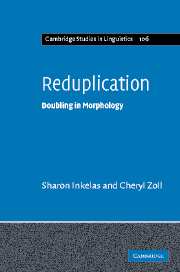Book contents
- Frontmatter
- Contents
- Acknowledgments
- Table of languages
- Abbreviations used in morpheme glosses
- 1 Introduction
- 2 Evidence for morphological doubling
- 3 Morphologically conditioned phonology in reduplication: the daughters
- 4 Morphologically conditioned phonology in reduplication: the mother node
- 5 Morphologically driven opacity in reduplication
- 6 Case studies
- 7 Final issues
- Notes
- References
- Index of languages
- Index of names
- Index of subjects
- References
References
Published online by Cambridge University Press: 24 February 2010
- Frontmatter
- Contents
- Acknowledgments
- Table of languages
- Abbreviations used in morpheme glosses
- 1 Introduction
- 2 Evidence for morphological doubling
- 3 Morphologically conditioned phonology in reduplication: the daughters
- 4 Morphologically conditioned phonology in reduplication: the mother node
- 5 Morphologically driven opacity in reduplication
- 6 Case studies
- 7 Final issues
- Notes
- References
- Index of languages
- Index of names
- Index of subjects
- References
- Type
- Chapter
- Information
- ReduplicationDoubling in Morphology, pp. 225 - 244Publisher: Cambridge University PressPrint publication year: 2005



